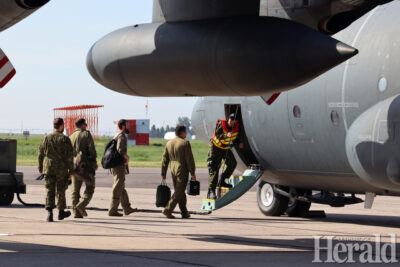Search and rescue exercises underway on local terrain
By Lethbridge Herald on June 7, 2023.
 Search and Rescue technicians board a C-130 Hercules Wednesday at the Lethbridge airport as part of several days of training by 435 Transport and Rescue Squadron.
Herald photo by Al Beeber
Search and Rescue technicians board a C-130 Hercules Wednesday at the Lethbridge airport as part of several days of training by 435 Transport and Rescue Squadron.
Herald photo by Al BeeberAl Beeber – LETHBRIDGE HERALD – abeeber@lethbridgeherald.com
Five days of search and rescue training by the 435 Transportation and Rescue Squadron of the Royal Canadian Air Force began here Monday.
A total of about 100 personnel from elements of the Canadian and American military will be operating out of the Lethbridge airport for the annual search and rescue exercise.
Chinthex 23 involves multiple disciplines utilizing the diverse terrain in southern Alberta for the search and rescue training.
Chinthex refers to the Winnipeg-based squadron’s nickname the “Chinthe” Squadron which was formed in Burma – now known as Myanmar – during the Second World War.
A chinthe is a mystical lion that is often seen flanking the entrances of Buddhist temples and pagodas in Burma.
435 Squadron commander Lieutenant-Colonel Joshua Levesque told media on Wednesday morning as personnel prepared for the first day of training that “every year the 435 Squadron and most of our SAR units have a yearly annual SAR (search and rescue) training exercise” and this year Lethbridge was chosen for it,” said Levesque.
Two C-130 Hercules from the 435 are involved along with a CH-149 Cormorant helicopter based at 19 Wing in Comox, B.C. There are also members of two squadrons from the U.S, one based out of Minot, North Dakota and the other out of Fairchild Air Force Base in Washington state here this week.
Personnel from Florida and the HMCS Tecumseh, the naval reserve division in Calgary, are also involved.
The different scenarios have been developed that encompass different training opportunities.
Scenarios involve high angle mountain work, water rescues, and searching for a lost aircraft among others.
“We’re working to build synergies that better understand each other’s capabilities to effect in rescues in more dangerous dynamic situations,” said Levesque.
Civilian ground search and rescue teams and members of the Civilian Air Search and Rescue Association are also participating in the exercises.
The exercises increase understanding of participants can provide each other in the event of a real-world scenario.
Levesque said part of the international SAR mandate requires nations to help each other out when people are in distress,” he said. As an example, 435 a few years ago helped search for lost boaters on Lake Michigan.
“We frequently have situations where we help out each other’s agencies on behalf of our citizens so it’s very important to have these events,” Levesque added.
Captain Jules Pankoski, the organizer of the exercise, said “in Manitoba where we’re based out of it’s mostly flat prairie. But being able to operate out of Lethbridge, it’s only a stone throw away from the foothills and the Rocky Mountains so it gives us some diverse terrain that we can work in that we could be expected to be going to work on an operational call,” Pankoski said.
While training is done on an almost daily basis, exercises such as this are important, he said, because they don’t always get to work with different agencies they would work with on an actual SAR call.
“So being able to bring everyone all together in one spot and to be able to more realistically replicate how we would work together on a call is really important,” added Pankowski.
Organizing Chinthex 23 was “an entire team effort supported by many other people all with their own skills that they bring to the table. Obviously there’s a huge logistical footprint to bring over 100 people all to Lethbridge,” he said.
“It did take quite a few months of planning, talking to other units.”
One scenario Wednesday had an aircraft flying to Cranbrook, B.C. to do a simulation of having electrical issues with the goal being to make it back to that city. Another plane was going to escort it back to Cranbrook because in the scenario the first plane might have trouble navigating due to those issues.
“In the scenario itself, we’re going to simulate that it won’t be able to make it to Cranbrook so there’s a ground team set up and our search and rescue technicians are going to jump to the ground by parachute, provide medical aid on the ground and then they’ll be evacuated to a hospital,” Pankowski said.
Other scenarios include a floatplane crash at Beaver Mines Lake with another team to be deployed there where they will parachute down. HMCS Tecumseh will have a boat on the lake and a helicopter will extract the plane’s occupants.
Other scenarios will take place in the Porcupine Hills and the mountains, he said.
Warrant officer Eric Beaudoin, the SAR technician leader of 435 Squadron, said exercises like this are important because a mission can happen any time of day and “we have to be alert constantly.
The interaction between agencies is an important part of the exercise, he added.
28-27



